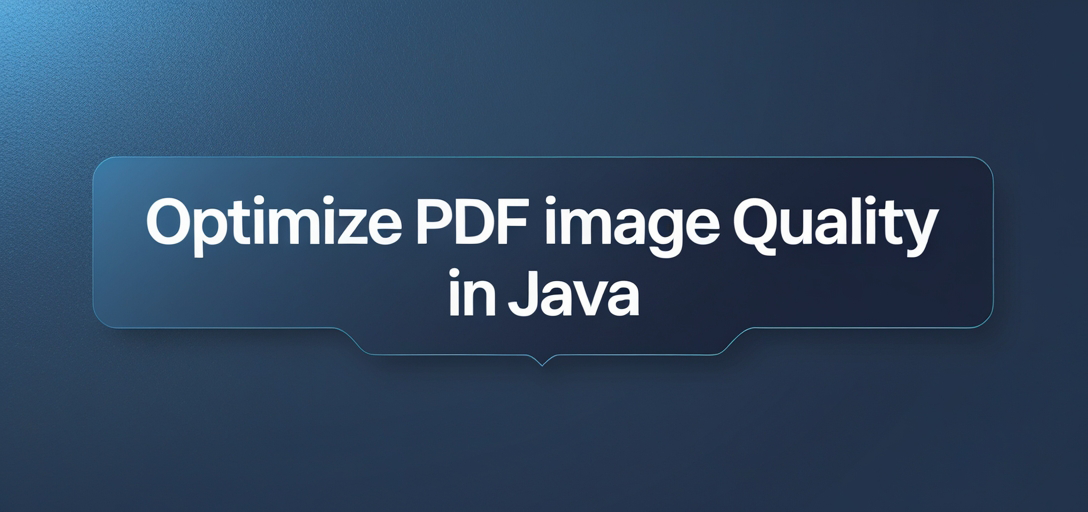How to Optimize PDF Image Quality in Java with GroupDocs.Viewer
Introduction
Are you looking to maintain high-quality images when converting PDF documents while controlling file size? Balancing image quality and file size is crucial, particularly with large documents or online sharing. GroupDocs.Viewer for Java allows you to efficiently adjust image quality when rendering PDFs into HTML format. This tutorial will guide you through optimizing image quality in PDF files using GroupDocs.Viewer.

What You’ll Learn:
- Setting up and configuring GroupDocs.Viewer for Java.
- Step-by-step instructions on adjusting image quality within a source PDF document.
- Best practices for optimizing performance when rendering documents.
- Practical applications of this feature in real-world scenarios.
Let’s start with the prerequisites before diving into implementation.
Prerequisites
To follow this tutorial, ensure you have:
- A basic understanding of Java and Maven-based projects.
- An installed Java Development Kit (JDK) version 8 or above.
- Access to a development environment for running Java applications.
- GroupDocs.Viewer for Java library integrated into your project.
Setting Up GroupDocs.Viewer for Java
Installation with Maven
Include GroupDocs.Viewer in your project by adding the following configuration to your pom.xml file:
<repositories>
<repository>
<id>repository.groupdocs.com</id>
<name>GroupDocs Repository</name>
<url>https://releases.groupdocs.com/viewer/java/</url>
</repository>
</repositories>
<dependencies>
<dependency>
<groupId>com.groupdocs</groupId>
<artifactId>groupdocs-viewer</artifactId>
<version>25.2</version>
</dependency>
</dependencies>
License Acquisition
Start with a free trial or request a temporary license to explore features without limitations. For long-term use, consider purchasing a license from the GroupDocs purchase page.
Basic Initialization and Setup
Once GroupDocs.Viewer is added to your project, initialize it in your Java application:
import com.groupdocs.viewer.Viewer;
import com.groupdocs.viewer.options.HtmlViewOptions;
// Initialize Viewer object with the path to your PDF document
try (Viewer viewer = new Viewer("YOUR_DOCUMENT_DIRECTORY/SAMPLE_PDF")) {
// Configure view options for rendering
}
Implementation Guide
Optimize Image Quality in GroupDocs.Viewer
Optimizing image quality is crucial when converting PDFs, allowing you to balance between clarity and file size. Follow these steps:
Step 1: Define Output Directory Path
Specify where the converted HTML pages will be saved.
import java.nio.file.Path;
import java.nio.file.Paths;
Path outputDirectory = Paths.get("YOUR_OUTPUT_DIRECTORY");
Step 2: Specify Page File Format
Use a dynamic naming pattern for generated page files.
Path pageFilePathFormat = outputDirectory.resolve("page_{0}.html");
Step 3: Create HtmlViewOptions Object
Configure HtmlViewOptions with embedded resources and set the file path format.
import com.groupdocs.viewer.options.HtmlViewOptions;
import com.groupdocs.viewer.options.ImageQuality;
HtmlViewOptions viewOptions = HtmlViewOptions.forEmbeddedResources(pageFilePathFormat);
Step 4: Set Image Quality Level
Choose an image quality setting. Here, we use medium quality.
ImageQuality quality = ImageQuality.MEDIUM;
viewOptions.getPdfOptions().setImageQuality(quality);
Step 5: Render the PDF Document
Initialize the Viewer with your source document and render it using configured options.
try (Viewer viewer = new Viewer("YOUR_DOCUMENT_DIRECTORY/SAMPLE_PDF")) {
viewer.view(viewOptions);
}
Troubleshooting Tips
- File Path Issues: Ensure paths are correctly set relative to your project’s root.
- Library Compatibility: Check for compatibility issues between GroupDocs.Viewer and other libraries.
Practical Applications
- Document Sharing Platforms: Optimize PDFs for online viewing without compromising quality.
- Archiving Systems: Balance file size and image clarity when storing documents long-term.
- E-Learning Materials: Enhance engagement with high-quality visuals in educational content.
Integration possibilities include combining GroupDocs.Viewer with cloud storage solutions or document management systems to streamline workflows.
Performance Considerations
- Optimize memory usage by managing resources effectively during the rendering process.
- Use appropriate image quality settings based on your specific use case to minimize processing time and resource consumption.
Conclusion
You’ve learned how to optimize PDF image quality using GroupDocs.Viewer for Java, allowing you to customize document presentations according to your needs. As a next step, explore more advanced features of the library or integrate it into larger projects.
Call-to-action: Implement this solution and see improvements in your document management processes!
FAQ Section
What is GroupDocs.Viewer for Java?
- A versatile library that allows rendering of various document formats into HTML, image, and other popular formats.
How do I change the output format from HTML to images?
- Use
ImageViewOptionsinstead ofHtmlViewOptionswhen configuring your view options.
- Use
Can GroupDocs.Viewer handle large PDF files efficiently?
- Yes, with proper memory management and performance optimization techniques in place.
Is there a way to batch process multiple documents at once?
- Implement loops within your Java application to iterate through multiple document paths.
How can I ensure optimal image quality for printed documents?
- Adjust the
ImageQualitysetting to high or custom levels based on your printing requirements.
- Adjust the